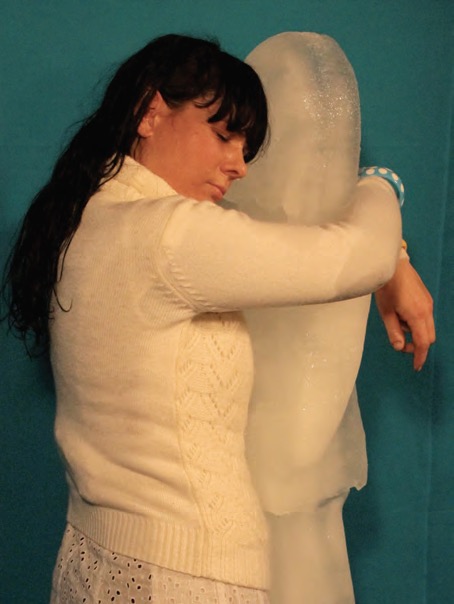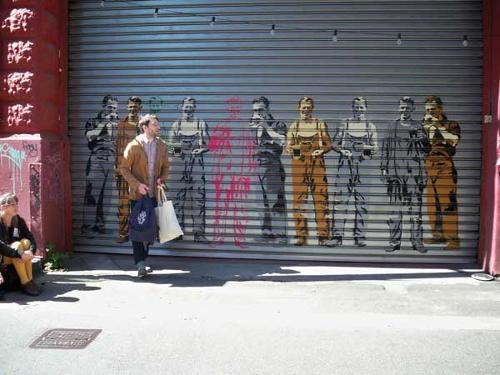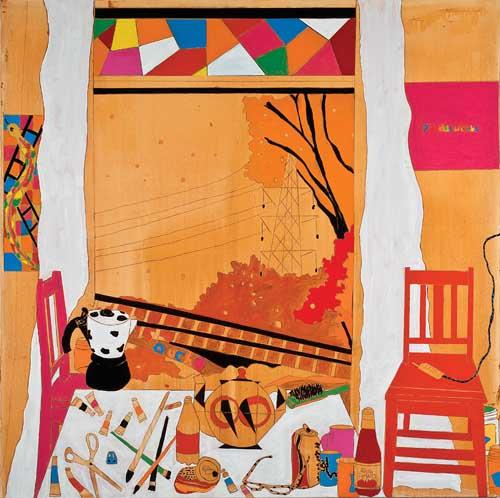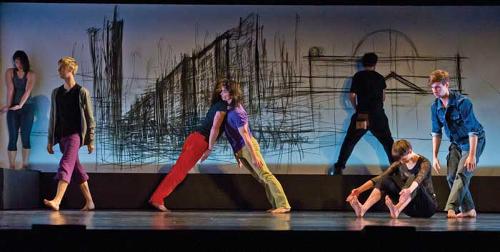
Over the last several years Ray Harris has made physically tangible an array of otherwise indescribable states of emotion and mind. Predominantly, these have been playfully conjured through film into which she casts herself, and interactive boxes or vessels into which she casts her audience. With some exception her works have been of a moderate scale, comparable to watching an average enlarged television or peering into containers around the house. These interactions have felt spectator-focused; aimed at visual engagement and a containment of the view to encourage projection into the created space or scenario from the comforting distance of the mind's eye. In Hold me Close and Let me Go Harris has continued to make participatory spaces for the mind but considerably expanded her scale to immerse the body in its entirety. Her two films, whose titles combined become the name of the exhibition, loom over opposing walls to form an unavoidable passageway which leads to five wooden boxes of very small room size, each fitted with single entry points, collectively titled I’ve been here before.
It is likely we have been here before, inside these rooms, for they are disturbingly familiar, yet simultaneously ambiguous. Each box stages a space that typically only exists within the fabrications of the mind - or in theme parks, fictitious narratives (read and screened), or in art. The very presence of these immersive scenarios, equipped with sound, smell, light, differing spatiality and material triggers, orchestrate experiences akin to psychological and emotional delving where participants bring their own mindset, associations and histories. Unlike the theatre of cruelty that confrontationally subjected audiences to the challenges of 'art’, Harris makes her participatory experience self-led, thus self-forming. The dark earth room for one, with its endless tunnel leading into the ground, provides burrowing comfort, an escape route or cloddish claustrophobia, given your pre-existing fears, time spent inside, or whether the door stays closed or open. The water room, lined with white cooling insulation, coiling tubes and fountains of dripping clear plastic bags, not only insinuates the cold site of horror scenes, but an emotional leakiness, or a futuristic garden. Effectively they offer potentially limitless opportunities for individual journeys and trajectories.
Harris’ practice continues to incorporate the body; hers, yours, a stand-in. In Let me Go, an eight minute film in a warm set of red, she lies with a body made of dough, comfortably at first and culminating in a grappling sticky push and pull, finally wresting herself away from the clingy other (though bits remain stuck). The couple, artist and dough, could represent a variety of relationships, parental, spousal, familial or other, but clearly one struggling over space. Opposite, against a backdrop of blue, is another struggle in Hold me Close. Harris, hugs, leans on then lies with a life-size icicle, a cold being taking in her warmth to slowly transform and melt away. While there is immediacy and explicitness to these emotionally-driven works, Harris’ commitment to her acts of enacting the faux bodies, sometimes to the point of endurance, is unswervingly and captivatingly real. There she is, projected large, subjecting herself to these states (which in the past also include spitting glitter, slapping herself in the face with paint, shampooing maniacally) and there is a power in this realness and no-nonsense presence.
What is also recurrently striking about Harris’ art is that there is no allusion to spectacle, no slickness and all is as appears. Her rooms are unmistakably boxes of raw timber lined with everyday materials ranging from mirrors, fabric, water, dirt to plastic flowers held in place by glue and nails. And her films are in real-time (with the occasional unhidden edit) and embrace a lo-fi quality using draped sets that leave their constructedness apparent. As such these artworks are at-once aesthetically read as ‘artifice’ as described by Johanna Drucker in her book Sweet Dreams: contemporary art and complicity; we are aware of and willingly share in their construction as ‘art’. This blatancy requires some generosity and the ‘suspension of disbelief’ on the participant’s part, when watching or entering the art to temporarily and permissibly be overtaken by, taken out of, or even taken into, other states of mind. The outcome though, of the giving-it-all-away and giving-in, effectively directs the experience away from questions that probe the ‘how’ of it all, to instead allow space for contemplation and symbolic interpretation. In line with Rex Butler’s recent essay ‘Please Don’t Touch’, importantly it is through both absence and ambiguity and a quirky mix of overtness and openness that Harris leaves space for her works to ‘touch’.












